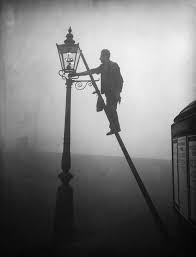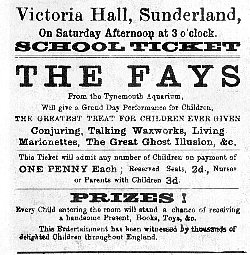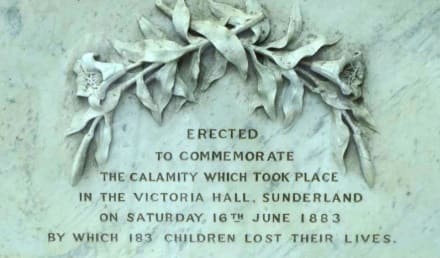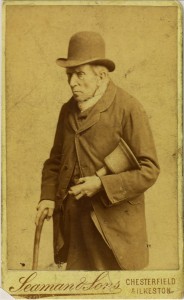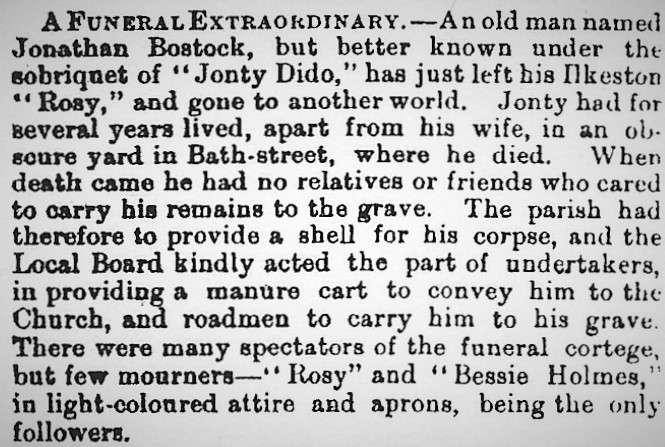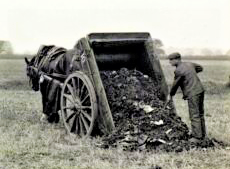After the Higgetts, Adeline leads us to ” Mount Street, where lived Jonathan Bostock, or as he was commonly called, ‘Jonathan Trot’ or ‘Jonty Trot’, lived in one of the two tiny cottages at the top of Mount Street. He was a bellman*** (below) and afterwards our first lamplighter.”
“A few years ago I was staying for a time at Woolacombe, in North Devon. This small seaside resort was owned by a lady, and she would not allow gas to be introduced into the place.
“One night I chanced to see a man carrying a short ladder on his shoulder. I followed and saw him light the six oil lamps that illuminated the two streets of Woolacombe.
“This scene brought back to my mind the time of my childhood, when I used to see ‘Jonty Trot’ trot from one lamp to another with his ladder on his shoulder.”
*** BELLMAN Employed as a watchman or town crier or who worked for the post office and collected letters for the mail coach by walking the streets and ringing a bell.
Born on April 12th 1811 Jonathan Bostock was the son of Bath Street brickmaker William and his first wife Elizabeth (nee Beardsley), married Ruth Morris, daughter of framework knitter John and Elizabeth (nee Daykin) in May 1831, and lived most of his married life in the Mount Street area of Bath Street.
The couple had at least nine children.
Friends …..
‘Jonty Trot’ or ‘Derby Trot’ got his name through having made the journey (allegedly) on foot to Derby and back to Ilkeston, three times in 12 hours, for a wager, a distance of 60 miles. In August 1843 the London ’Era’ noted in its Sports section, under the heading of ’Pedestrianism’, that ……
“on Monday (July 31st), a man named Jonathan Bostock, undertook to walk from Ilkeston to Derby three times, making a distance of 60 miles in 14 hours, which feat he performed within 12 hours”.
“I can remember going down Cordon’s Lane, as it was then called, to meet him, coming in the last time”
Thus wrote Enquirer to the Ilkeston Pioneer in 1891; Cordon’s Lane was probably Moors Bridge Lane, later Derby Road, and in 1843 was home to farmer Henry Cordon and his family.
And here is John Cartwright recalling his Market Place employer’s encounter with ‘Jonty’ …
“Mr Thomas Merry – father of Alderman W. Merry, with whom I was an apprentice, and to whose kindness I owe much –was once driving to Nottingham, and overtook Jonathan, when perhaps, halfway on his journey.
Said Mr. Merry “Jonathan, will you have a ride?”
And the reply was “No, thank you, sir, I can’t stop now.”
At that time pedestrianism was a popular spectator sport.
Framework knitter, messenger, bill poster, town crier, lamplighter, Jonathan was known by everyone and “despite his eccentricities everyone had a favourable word for him. However it cannot be said that he was ‘anything of an ornament to society’ and his sense of dress was erratic and unconventional”.
He was regarded as a very trustworthy man, always ready to undertake a journey no matter how far he had to go. For about 25 years he was ‘agent’ for the Pioneer and his weekly newspaper round took him to as many as 17 villages in the area.
… and enemies
Not everyone got on well with Jonty however.
One cold Saturday evening in November 1864 the billposter entered the Poplar Inn to sell a few newspapers only to find himself confronted by coalminer Abraham Trueman, who was not interested in buying from Jonty and told him to leave — threatening to knock his bloody head off if he didn’t.
Witnesses testified that Abraham then pushed Jonty onto a bench, causing him to fall and injure his side. He was further assaulted outside but it was too dark to positively identify the assailant.
Nevertheless Abraham was convicted of assault and fined… and ordered to pay up or one month’s hard labour in Derby jail.
(Three years earlier, the coalminer had spent a couple of months at that same institution for another assault, this time on his second wife Hannah (nee Hallsworth).
The pair had been married less five weeks before her husband’s neglect and threats led Hannah to return to her parent’s home in Hallsworth Row.
Her departure did not inconvenience Abraham however as he had already developed a liaison with his first wife’s younger sister and now moved to live with her in New Street.
An assault on Hannah just before Christmas of 1861 led Abraham to spend his time in Derby jail).
At the Parliamentary election of 1865, Jonathan acted as a bill-poster for the Conservatives.
One day saw him happily pasting election notices on the churchyard wall, by the Vicarage. Following him, however, was ardent Liberal supporter, William ‘Billy’ Mitchell of Pimlico — brother of Abraham and also a shoemaker/cobbler — who was pulling off all of Jonty’s good work from the wall.
The bill-poster was usually a very even-tempered man but this was too much for him. He lost control and used his pasting brush to paste ‘Billy’ who was knocked to the ground, badly but not fatally injured.
———————————————————————————————————————————————–
The journeys of Jonty
Question: Was this Jonty?
In August 1873 a certain Mr. Jonathan Bostock, aged 63, was found lying helpless and asleep in a ditch at Kimberley and a few days later was found upright and fully awake — in the dock at Nottingham Police Court.
The circumstances under which he came to be in the first place were disputed; those under which he came to be in the second place were perfectly clear.
It all started when Jonathan found himself in possession of surplus copies of a weekly publication which he had tirelessly but fruitlessly been trying to sell for several days. (A clue?).
In an effort to get rid of some of the surplus he visited the flower show at Ilkeston where he roused the attention of prospective purchasers by ringing his bell. (Another clue?)
The ‘exertions’ of that day and of the previous week had so worn out Jonathan that he was utterly exhausted. He had not taken his clothes off for a week – was this why no-one was buying from him? – and going along the road he felt as though ‘sand was in his eyes’. Thus at Kimberley he sat down by the ditch, lay his head in the dyke and was quickly overpowered by sleep.
At least that was his story and he was sticking to it!!
Police Constable Gibbons, who found the inert Mr. Bostock, had an alternative interpretation.
His first thought was that the latter was drunk and incapable. He tried to rouse the man, shook him and then rang his bell close to his ear. Not a murmur. Jonathan was temporarily dead to the world. Nothing more could be done except place the body in a horizontal position and wait for a natural awakening which occurred some hours later – when Jonathan also discovered that he had been summoned for drunkenness.
Hence his appearance at the Shire Hall.
After hearing some enervating evidence about the contents of the ditch – whether it was Jonathan’s drunken vomit or spilt pig manure – the magistrates consulted together.
Taking into consideration the fact that Mr. Bostock had never come to the notice of the Bench before, they were prepared to afford him the benefit of any doubt.
Case dismissed.
Jonathan was profuse with thanks and collected his unsold papers and his bell from the police, who had kindly guarded the items for him, and went on his way rejoicing.
Answer: Most probably Yes!!
P.S. If this was Jonty, what was he doing in Kimberley? – just stretching his legs with a short walk??
————————————————————————————————————————————————————-
In May 1874 Jonty was over the border (again?) – this time on the highway in Nuthall — in a similar horizontal position.
P.C. Gibson found him in a drunken torpor, lying amongst a collection of papers, some turnips, and of course with his trusty bell.
He was temporarily housed in a stable for the night before appearing yet again at Shire Hall.
Testimony of his previous good character and references from his employer did not save Jonty from a fine of 12s 6d.
Perhaps trying to repair a tarnished reputation (?), Jonty advertised in the Pioneer as Bill Poster of No.3 Mount Street;
“All work entrusted to him will be done at once”. (IP Nov 1876)
—————————————————————————————————————————————————
Jonty tries to batter Butters??
One evening in March 1879 Jonathan visited the Town Hall to collect payment from Mr. Fay the Ventriloquist who was appearing there and whose visit Jonathan had posted around town. However an altercation developed between the billposter and John Butters, assistant to the ventriloquist.
This led the latter to appear at the Petty Sessions, defending himself against a charge of assaulting Jonathan.
Conflicting evidence centred on the use of the town crier’s bell.
John maintained that Jonathan had arrived at the Hall far from sober – can you believe it!?! — clanging his bell, and when told to be quiet, swung it in the direction of John’s head. The latter’s quick reactions diverted the ‘missile’ but only into the face of his assailant, causing blood to flow.
Jonathan was adamant that he had not used his instrument as an offensive weapon, had not struck out at the assistant, and was the innocent and injured party.
Unfortunately for ‘Jonty’ several witnesses supported the alternative version of events and the case was dismissed.
Jonathan was left pondering how he was to get payment for the work he had done for Mr. Fay.
In May 1883 Mr. Fay was appearing at Victoria Hall, Sunderland, entertaining between 1500 and 2000 children, with conjuring tricks, talking waxworks and ventriloquism, living marionettes and various illusions.
What a rare delight for so many children so used to toil and tedium, entertained for a few hours of enjoyable escapism.
At the end of the performance, Mr. Fay and his assistants began to throw small treats to the excited, cheering children in the stalls but those in the gallery, thinking they were being overlooked, headed down the stairs to join in the fun.
As the tide of these frenzied children flowed down the staircase, a narrow bolted doorway faced them.
The pressure of the throng made opening these doors impossible and a crush developed which those at the top of the stairs were unaware of. The pushing continued as the children fell head over heels, piling on top of each other, their young life being crushed from those at the bottom.
183 children, mostly ages seven to ten, but two of them just three years old, died in the tragedy.
Jonty’s Reward.
In April 1881 Jonty’s wife Ruth died at their Mount Street home, aged 73.
Six months later a cricket match was organised at the Rutland Recreation Ground in aid of the ‘Old Trot’ when almost £1 was collected at the ground.
“’Trot’ has for forty years been the servant of everybody – never refusing to become a messenger by night or by day, on life or death, and his honesty during this long period of public service has never been questioned. As a bill-poster, the town-crier, and ‘Pioneer’ news vendor he has also done the public great service, and we are glad to see his old townsmen know how and when to appreciate such services”. (IP)
The subsequent contributors included many of the main tradesmen of the town and they raised the total amount to £5 2s 3d which allowed Jonathan to buy a good winter suit of clothing, from head to foot.
Jonathan hoped that “his remaining days will be spent in increased comfort at home and in the continued service of those who have befriended him, as well as the public generally”.
His new suit of clothing had to last eight years of ‘remaining days’.
Jonty Trot about 1888 (courtesy of Ilkeston Reference Library), modelling his new ‘Winter Suit’?? .. no longer so ‘new’?
It runs in the family ?
a) On March 4th 1885, John Bostock, bill poster of Ilkeston, was charged with being drunk in the highway at Ilkeston. He was found by the police, asleep and almost dead with the cold. Fined half-a-crown and 9s 6d costs.
Was this Jonathan’s oldest son John who was also a bill poster ?
b) Jonathan’s oldest daughter was Mary who married framework knitter Amos Lacey on February 11th, 1854. Forty years later and Mary had developed a habit of drinking herself almost into unconsciousness, and then lying down on the hearth in front of the fire. She did this one night in March 1885, at her home in Belvoir Terrace, and fell asleep, having locked herself in. Presently a neighbour heard groans from the house, saw smoke seeping out. He broke down the door and discovered Mary, standing against the wall and engulfed in flames. She was immediately taken to the Cottage Hospital where she died early the next morning.
provided by Ann Featherstone
———————————————————————————————————————————————————-
In July 1889 Jonathon, aged 82, died at the home of his daughter Maria and her husband, Charles Amos, in Trueman Street ‘having succumbed to the combination of diseases which appeared to afflict his latter days’.
————————————————————————————————————————————————————
Brother Thomas Bostock.
One of Jonty’s elder brothers was Thomas alias ‘Yellow Tom‘, “a thoroughly honest and thoroughly true, hard-working, reliable and strictly honourable man, and a staunch friend to all who needed his sympathy and aid”.
Thus he was described by the Telegraph for whom he acted as an ‘agent’ — though he also earned a living as a cowkeeper.
In his later years the outdoor life had not led to good health. Tom often complained of headaches, had difficulty in breathing, coughed a great deal, frequently spit blood, and suffered a swelling in his stomach and pain in his side from an accident.
One evening in September 1869 he came home after bringing in the milk, had a cup of tea with some bread and butter, and then left for his club at the Market Tavern. There he sat chatting for a few minutes with carter Thomas Lee, and suddenly died of ‘disease of the heart’.
He was 60 years old.
——————————————————————————————————————————————————–
Jonty Dido.
Jonty Trot was one of a pair of relatively aged ‘Jonathan Bostocks’ living in Ilkeston.
The other was known as ‘Jonty Dido’, — or simply ‘Jont’ or ‘Dido’ — a coalminer ten years older than Jonty Trot and who lived most of his life in Chapel Street. He was the half first cousin once removed of Jonty Trot
In December 1822 he married Edith Keeling, daughter of West Hallam framework knitter Francis and Ann (nee Shaw), and separated from her several years before 1871. On the census of that year he is at Bath Street Place while his wife is living as ‘a widow’ in Ebenezer Street with her youngest child David, her married daughter Harriet and the latter’s husband Henry Sills.
Edith did become a real widow in May 1874 when Jonty Dido died at Bath Street Place, aged 74.
Jonty’s funeral was a bleak affair. He had no friends or relatives willing to carry his body to its grave so that the parish had to supply this service.
Most of his nine children were either dead (Henry, Pharoah, Robert and Sarah) or had moved out the area (Ann, Maria and Jonathan). Daughter Harriet and youngest child David were still residing in Ilkeston but ‘chose’ (?) not to attend.
Acting as undertakers, the Local Board provided a manure cart to transport his body to the Church where the Board’s roadmen then took it to the grave.
At the graveside there were but two ‘mourners’, one being his widow, though there were many spectators of the funeral cortege.
Edith was a widow for just over a year. She died at Cotmanhay in June 1875.
——————————————————————————————————————————————————————-
Another town crier
A predecessor of ‘Jonty Trot’ was ‘Old Billy Deverill’ … William Deverill who died in Moors Bridge Lane (later Derby Road) in 1845, aged 85
“What a voice he had when anything was lost, stolen, or strayed !! I was going to say, you might have heard him from one end of the town to the other. At the sound of his bell we used to flock round him, to hear the news. Being blind, he had no paper to read. His street orations were, therefore, all extempore. His quaint remarks very frequently provoked a deal of laughter from the bystanders. We used to make fun of him as he carried his lantern, when going to ring the eight o’clock bell, at the Church: there was no fear of his seeing a ghost : he would have been glad to have been able to see one”…… thus wrote ‘Progress‘ in the Ilkeston Pioneer (IP Apr 1853)
———————————————————————————————————————————————————–
And another ‘eccentric’ character….. John Watkinson
Earlier in the same year that Jonty Trot died, another Ilkeston ‘character also died. The Nottinghamshire Evening Post reported upon it …
On Sunday afternoon (January 13th) a large crowd assembled at Cotmanhay, Ilkeston, to witness the interment of the remains of an eccentric character named John Watkinson who was found dead in his house on Wednesday last. Until a short time ago deceased had been in the workhouse, and at the time he was removed there he had in his possession a number of cannons made principally out of heavy iron piping, and about 2cwt of gunpowder.
He had never been married and was a thorough recluse. When ordered by the authorities to whitewash his house hw whitewashed the inside of his oven and the coal which were stored in one corner of the room.
On Sunday, before the funeral procession started from the house, a volley from the cannons was fired over the coffin, and they were then carried by the side of the coffin to the churchyard. Here it was proposed to fire another volley but the vicar declined to allow it to be done. The whole of the proceedings were watched with peculiar interest and created no little amusement.
———————————————————————————————————————————————————–
Another man of many talents
Richard Whitehead (c 1751-1832) died on March 19th, aged 81. The Nottingham and Newark Mercury recorded his achievements thus :–
Leaving a numerous progeny of four generations.
He was a man of various callings in life —
A maltster, maker of stockings, and pinder.
A drawer of teeth, bleeder, and ringer.
A fiddler, poet, and psalm singer.
On a stone in the church-yard is the following singular inscription, which he wrote on the death of a favourite aunt.
God takes the good — too good on earth
And leaves the bad — too bad to take away.
———————————————————————————————————————————————————–
And who had the privilege of being Jonty’s neighbours ?

